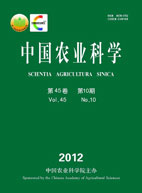-
Observation and Comparison of Chloroplast Structure in Hybrid and Different Cytoplasmic Male-sterile Wheat Lines
- YUAN Kai, GAO Qing-Rong, ZHANG Bao-Lei, YU Song, LI Nan-Nan, ZHANG Lei, LIU Huan, YANG Zhi-Yuan, FU Xiu-Yi
-
Scientia Agricultura Sinica. 2012, 45(10):
1887-1894.
doi:10.3864/j.issn.0578-1752.2012.10.001
-
 Abstract
(
827 )
Abstract
(
827 )
 PDF (1069KB)
(
916
)
PDF (1069KB)
(
916
)
 Save
Save
-
References |
Related Articles |
Metrics
【Objective】The aim of this study was to dicuss the relationship between CMS and chloroplast microstructure and to reveal the mechanism of CMS by investigating chloroplast micro-structural characters in CMS male-sterile lines.【Method】The experiment was conducted with cultivars of the K, V, T-type CMS lines, the common maintainer Ji 5418, the F1 hybrids and the cytoplasmic donors under field conditions. The transmission electron microscope was used to investigate the features and expression differences of the chloroplast microstructure of the flag leaf.【Result】 The chloroplast structure of K, V, T-type CMS lines were anomalous and showed that the boundaries of grana lamella of the choloraplast of were fuzzy, even disappeared, and also lag behind normal development. Meanwhile, the thylakoids among grana lamella were under developed and even ruptured, with the whole lamella disordered. But the maintainer line(B) Ji 5418’s chloroplast was in good condition and close to the intima, the grana lamella clear and in order, and the thylakoid among grana was clearly visible. The number of chloroplasts per cell of the maintainer line was significantly different from K- and V-type (F=40.47, Pr<0.0001), with 19.8 in K-type and 18.4 in T-type, respectively. Moreover, the K-and T-type CMS lines had round chloroplast. The number of chloroplasts per cell in CMS V-type is 24.8, which was observably higher than that of CMS K and T-type (F=40.47, Pr<0.0001), but did not significantly differ from the maintainer line (F=40.47, Pr<0.0001), with the number of chloroplasts of 24.1. Besides, the oblong chloroplast was found in CMS V-type CMS line and maintainer line. The donors of Aegilops kotschyi and Triticum timopheevii had round chloroplast, and oblong in Aegilops ventricos. Their boundaries of grana lamella of the choloraplast were fuzzy, the thylakoids among grana lamella were under developed and even ruptured. That is similar to K-, V-, T-type CMS lines, and they have the same source. The three kinds of chloroplasts of (A×R) F1 were oblong and close to the cell intimal. Their bi-layer epicyte were clear and cytoplasm were dense. Meanwhile, the cytoplasm was filled with grana and the thylakoids among grana were vivid and visible.【Conclusion】The number of chloroplast per cell in the maintainer line is higher than that of CMS K and T-type, but not different with CMS V-type. The CMS lines have abnormal chloroplasts, and significant cytoplasmic effect. Undoubtedly, restorer gene can not only restore fertility of the K, V, T-type CMS, but also make the chloroplast structure normal. Results of this experiment possesses values of production and application in wheat breeding.









